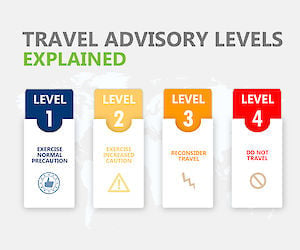The Travel Advisory System is an essential tool provided by the U.S. State Department, aimed at ensuring the safety of Americans traveling abroad. It offers crucial information and assigns safety rankings to various countries, guiding potential travelers on destinations to avoid. With travel advisory alerts updated frequently, this system helps individuals navigate international travel safety, especially in regions identified as high-risk, such as Ukraine and South Sudan. By understanding these advisories, Americans can make informed decisions and exercise caution when planning their trips. The State Department travel advisories serve as a vital resource for those wanting to stay safe while exploring the world.
The system for travel advisories functions as a significant mechanism for providing safety information to U.S. citizens embarking on overseas journeys. This guidance includes comprehensive ratings that classify countries based on security levels, essentially highlighting areas where travelers should exercise heightened vigilance or reconsider their travel plans. Alerts issued by governmental agencies note specific regions that present increased safety challenges, helping citizens gauge risks effectively. Each country’s advisories are meticulously updated to reflect current political climates, health issues, and potential dangers, forming a critical part of the travel planning process. Utilizing tools like these can enhance travel experiences by prioritizing personal safety and awareness, ensuring a more informed adventure.
Understanding the State Department’s Travel Advisory System
The State Department’s Travel Advisory System is a comprehensive framework designed to inform American citizens about the safety of traveling internationally. It assigns countries a safety ranking from Level 1 (Exercise Normal Precautions) to Level 4 (Do Not Travel), allowing travelers to make informed decisions based on current safety conditions. This structured approach helps assess risks from health epidemics to local crime and civil unrest, ensuring travelers remain vigilant and prepared ahead of their trips.
As part of this advisory system, the Department continuously monitors global events that could affect safety. For instance, significant incidents such as terrorist attacks prompt immediate updates to advisories, ensuring they reflect the latest information. The advisory details not only the risks but also recommends the necessary precautions travelers should take, providing guidance on health safety, local laws, and cultural practices that could impact their trip.
Key Elements of Travel Advisory Alerts
Travel advisories contain critical information that travelers should heed. For each country, the advisories outline essential details, including health conditions, local laws, and recommended vaccinations. For example, travelers considering going to India are advised to stay updated on regional advisories, particularly since security situations can vary greatly within the country. Notifications regarding the necessity for tourist visas, passport validity, and any travel restrictions are also included, which are crucial for a smooth travel experience.
Moreover, these advisories are not static; they evolve as situations change within a country. Regular updates ensure that travelers are aware of any developing threats or new safety protocols, such as travel bans or curfews. By following these travel advisory alerts, Americans can better navigate the complexities of international travel and mitigate potential risks.
U.S. Travel Safety Rankings Explained
The U.S. travel safety rankings play a significant role in informing travelers about the relative safety of various destinations. These rankings help Americans identify which countries pose higher risks and should be avoided, such as those categorized under Level 4 advisories like South Sudan and Ukraine. Understanding these rankings is crucial for travelers who may be unaware of the dangers they could face abroad, especially in regions with ongoing conflicts or unstable governments.
By placing countries on different safety levels, the State Department’s system allows travelers to gauge the level of caution required. For example, countries rated Level 2 encourage increased vigilance, emphasizing that while travel is possible, awareness of local situations is vital. This precise categorization ultimately aids Americans in making judicious travel choices, promoting overall safety while abroad.
Countries to Avoid Traveling Due to Security Risks
Certain nations are highlighted under the United States travel guidance as particularly dangerous. Countries placed under a ‘Do Not Travel’ advisory—like Afghanistan or Syria—are flagged due to severe threats posed by armed conflict, terrorist activities, and unpredictable local conditions. Travelers are advised against visiting these regions not only for their safety but also to avoid potential legal consequences associated with traveling to areas under strict advisories.
This precaution extends to areas within countries, too. For instance, regional advisories in places like India indicate that while some areas may be deemed safe for travel, others may still present serious threats. The ability to distinguish between different sections of a country provides travelers with targeted information that enhances their safety as they plan their journeys.
Travel Advisory Updates During Crises
In the face of global crises, the State Department frequently updates travel advisories to reflect real-time threats. Events such as natural disasters or political upheaval prompt swift revisions to existing advisories, allowing travelers to access the most accurate safety information. This proactive approach is crucial, as it armors travelers with the knowledge needed to adjust their plans or postpone trips to affected regions.
A notable example of this is the travel advisory adjustments following violent unrest or terrorist attacks, where locations can shift from being relatively safe to highly restricted overnight. The State Department emphasizes the importance of vigilance during such times, urging travelers to stay connected with real-time updates via their official channels, ensuring they have current intelligence before embarking on their journeys.
The Role of Technology in Travel Safety
Modern technology significantly enhances how the State Department conveys travel advisories to the public. With the rise of mobile apps and digital notifications, travelers can receive instant alerts about changes to their destinations’ safety rankings. This immediacy is vital in responding to urgent threats, as travelers can make quick decisions about altering their routes or destinations based on up-to-date information.
Furthermore, technology aids in providing comprehensive insights into local safety conditions. Travelers can access a wealth of data on health risks, entry requirements, and even real-time safety incidents through various online platforms, thereby empowering them to prepare thoroughly before international travel. This level of awareness helps minimize risks and enhances overall travel experiences.
Importance of Health advisories in Travel Planning
Health advisories are a critical component of the travel advisory system, informing Americans about endemic diseases and vaccination requirements specific to their destinations. For instance, travelers heading to areas where diseases like Zika, malaria, or yellow fever are prevalent must ensure they are vaccinated and equipped with preventive measures. Guidance from the State Department regarding health risks helps travelers safeguard their well-being while exploring new countries.
In addition to vaccinations, the travel advisory alerts include essential information about local healthcare facilities and health codes that might differ from those in the U.S. Awareness of how to access medical services and the potential need for travel insurance creates a safer travel environment. By prioritizing health advisories, travelers can mitigate health risks, ensuring their adventures abroad remain enjoyable.
The Impacts of Travel Advisories on Tourism
The State Department’s travel advisories significantly influence tourism patterns, as safety rankings can deter potential tourists from visiting certain countries. For instance, regions marked under ‘Do Not Travel’ typically experience a decline in tourist activity. These advisories not only inform individual travelers but also shape broader trends in international tourism and the economy of affected nations.
Conversely, countries with positive advisories may experience growth in tourism, utilizing favorable safety rankings to promote their destinations. This responsiveness to advisories underscores the importance of travel safety in guiding both personal decisions and broader societal trends regarding international travel, highlighting the connection between safety perceptions and tourism economics.
Future of Travel Safety and Advisory Systems
As global travel continues to evolve, the future of travel safety and advisory systems will likely incorporate advanced data analytics and real-time information gathering. The integration of machine learning and AI could enhance the accuracy and timeliness of travel advisories, allowing for predictive assessments of potential risks based on emerging threats. Such innovations can empower travelers with deeper insights into safety conditions, fostering a more informed travel experience.
Additionally, as travel becomes increasingly accessible, the State Department may expand its advisory reach to include more nuanced region-specific data, making it easier for travelers to navigate complex international landscapes. The adaptation of these systems plays a crucial role in promoting U.S. citizens’ safety and ensuring they can travel with the right knowledge and preparations to manage risks effectively.
Frequently Asked Questions
What is the State Department travel advisory system?
The State Department travel advisory system provides safety rankings and travel recommendations for U.S. citizens considering international travel. It categorizes countries based on risk levels and includes critical information on health, entry requirements, and safety conditions.
How does the U.S. assign travel safety rankings to countries?
The U.S. assigns travel safety rankings through a comprehensive assessment of various factors, including security risks, health conditions, and local laws. These evaluations inform travelers of areas to avoid and safe regions to visit.
Are there countries to avoid traveling to according to the State Department’s advisories?
Yes, the State Department issues travel advisories that identify countries deemed high-risk. Examples include places under a ‘Do Not Travel’ advisory, such as Ukraine, South Sudan, and certain regions of India.
What information is included in travel advisory alerts from the State Department?
Travel advisory alerts from the State Department include safety rankings, entry and exit instructions, health advisories, required vaccinations, visa requirements, and any important local laws that could affect travelers.
How often does the State Department update its travel advisories?
The State Department regularly updates its travel advisories to reflect changing conditions. These updates ensure that American travelers are informed about current risks and necessary precautions when traveling internationally.
What are the international travel safety levels provided by the State Department?
The international travel safety levels range from Level 1 (Exercise Normal Precautions) to Level 4 (Do Not Travel). Each level provides clear guidance on the safety and security risks in a destination.
What should travelers do if a country is under a high-level travel advisory?
If a country is under a high-level travel advisory, travelers should reconsider their plans and follow the guidance provided. It is advisable to stay informed of any developments and assess personal safety before traveling.
Can travelers get specific advisories for different regions within a country?
Yes, the State Department provides specific advisories for different regions within a country. For instance, India has varying advisories for different states and territories, allowing travelers to make informed decisions based on their destination.
What are the implications of traveling to a country with a ‘Do Not Travel’ advisory?
Traveling to a country with a ‘Do Not Travel’ advisory can pose significant risks, including potential safety threats and limited access to assistance. Travelers are strongly urged to avoid such destinations and heed the warnings issued by the State Department.
How can travelers access the latest State Department travel advisories?
Travelers can access the latest State Department travel advisories by visiting the official State Department website, where they can search for specific countries and view updated safety information and travel alerts.
| Aspect | Details |
|---|---|
| Travel Advisory System | A system used by the U.S. State Department to assign safety rankings to countries for American travelers. |
| Purpose of Advisories | Guide Americans on safety, health conditions, entry requirements, and security risks when traveling abroad. |
| Levels of Advisories | Advisories range from Level 1 (exercise normal precautions) to Level 4 (do not travel). |
| Recent Events | The advisory system responds dynamically to events, like the Kashmir terrorist attack prompting an alert for the region. |
| Country-Specific Advisories | Some countries have regional advisories, with different warnings for specific areas (e.g., India, Philippines). |
Summary
The Travel Advisory System is a crucial tool for U.S. travelers, providing up-to-date safety and security information for countries worldwide. It helps individuals make informed decisions about their travel plans based on real-time events and conditions in various regions. By regularly updating these advisories, the State Department ensures that travelers receive necessary warnings that could impact their health and safety, especially in regions experiencing instability. Understanding this system allows Americans to navigate foreign travel safely, adhering to travel advisories that communicate essential guidelines for entry requirements, health risks, and overall safety.



